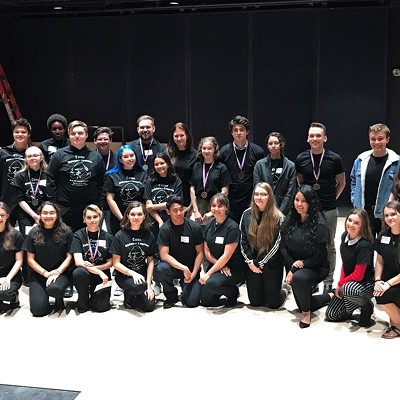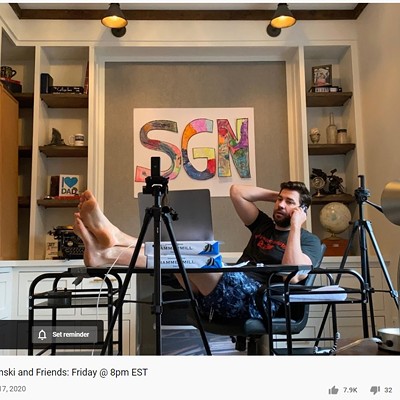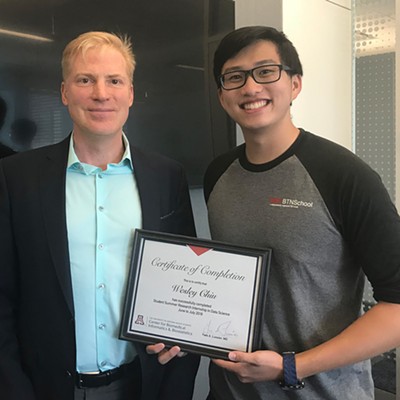After several days spent talking with principals, students and teachers from different areas of town, impressions abound, but hard questions remain: Why do some children have better access to resources? What is the price of insinuating "privilege" in some public institutions? Why do magnet schools with good programs not easily attract white students?
Bewildered parents and taxpayers concerned over public education are barraged with news about test scores, achievement standards, teacher dissatisfaction and, of course, the media's favorite topic--violence. But the picture of high-school student life conveyed in headlines and television news is inadequate. Many parents, caught up in earning a living and with barely enough time to make sure their own children are OK, may lack the resources needed to find out what, exactly, is going on in the public schools.
It might appear that graduates from high schools as disparate as Cholla and Sahuaro have little in common. On the contrary, teenagers at opposite ends of town share many similarities. But differences remain.
It's mid-morning and Pete Bourret is pacing. His class of advanced-placement English at Sahuaro is in the process of having senior photos taken. As a result, his students will miss most of the period. Students being excused from academic time for photos, athletics, student government and myriad activities are among his pet peeves. A teacher since 1972, Bourret says there is "no easy answer" to what he views as the most significant change in 25 years of teaching.
"Parents fill children's wants, not their needs," he says. He would like to see parents provide more critique of television. Put-down humor and shows such as The Weakest Link encourage the young to use people to get what they want and "sell their souls for money," he complains.
Yet none of the students in today's class seem interested in devilish dealings. Much of what they envision over the course of the next 20 years is a slice of the middle-class American Dream: marriage, career, nice house, car, financial security, kids. Some of what they hope for is poignant: happily married, not divorced, stable job, sons bonding over sports.
With more than half the class period gone to photos, Bourret still has enough time to confiscate a ringing cell phone. The class ends, students stream out, and the teacher's facial expression is clear: There is not enough time for teaching.
Across town on another day, Linda Santa Cruz waits for her late morning government class at Cholla to begin. She describes her students as "good kids with good hearts," and her perception is soon borne out. It's 11:30 a.m. and "first lunch" is over. The classroom fills with the energy of 17- and 18-year-olds. A young man takes a seat at the back of the room and greetings are voiced. Tones are wry, but it's clear the sentiments are genuine.
"It does my heart good to see you, man," he says, addressing a nearby classmate.
"It does my heart good to see you too, man."
Soon the class is engaged in a lively discussion of due process and police power. The pace is quick and the questions insightful. Santa Cruz reminds the students that government class is a graduation requirement and urges them to hang on to their papers. A discrepancy over grades is serious, and her students know she wants to see them succeed.
But success is a slippery concept, and inconsistencies remain in the public school system. Jean Anyon addresses differences in the quality of education by social class in "Social Class and the Hidden Curriculum of Work," an essay first appearing in Journal of Education. Anyon uses four school designations: working-class, middle-class, affluent professional, executive elite. Part of the essay describes teaching styles, classroom arrangements, how the students' work is differently evaluated in each of the schools.
Anyon's New Jersey schools are a distance from Tucson, but why the subtle yet startling difference in the way four students here answer the same question? Shanelle Enriquez and Estevan Orantez--members of Cholla's class of 2001--and Adam Durazo and Hillary Hart--their Sahuaro peers--talk about future plans. Shanelle sees herself someday working in the field of physical therapy, and Estevan envisions architecture. At Sahuaro, Adam wants to be an audio engineer, while Hillary plans to be a lawyer. The way these young people respond raises a question: Why do the students from Cholla see themselves in a field of work--Estevan said "architecture," not architect, which could imply merely drafting--while those from Sahuaro name a specific profession, such as "lawyer"? Despite the best intentions of some educators, what contributes to how students set their future goals? Are Sahuaro students trained to set their sights higher than their Cholla peers?
Over a dozen students volunteer to talk to the Weekly. They lead busy lives; most of the teenagers say they have no free time. Senior prom earns high grades as a memorable experience, while winning at football after a lengthy losing streak is another. Indications are that the competitive spirit is alive and well, but, according to one student, there is also "lots of apathy."
Students from both schools share the opinion that high school was not academically challenging. If any of them found it difficult, they are not saying. Though the general consensus among students rates high school as "medium to easy," several note "it depends on effort." A senior from Sahuaro complains that TUSD did not "demand excellence."
Meanwhile, at Catalina Foothills High School, students are not talking at all. Since the school could fit Anyon's designation of executive elite, it's no surprise when Wagner Van Vlack, the incoming principal, says the "accountability committee" is responding to the Weekly's request with a "polite no." Talking with students about their high school experiences will be a "distraction" from the school's "mission." Keeping Anyon in mind, maybe the school's mission is to produce citizens who can choose to ignore public scrutiny.












